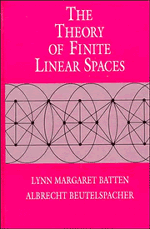Book contents
- Frontmatter
- Contents
- In memory of PAUL de WITTE 1931–1980
- Preface
- 1 The essentials
- 2 Complementation
- 3 Line sizes
- 4 Semiaffine linear spaces
- 5 Semiaffine linear spaces with large order
- 6 Linear spaces with few lines
- 7 d-Dimensional linear spaces
- 8 Group action on linear spaces
- Appendix
- Notation index
- Subject index
8 - Group action on linear spaces
Published online by Cambridge University Press: 05 May 2010
- Frontmatter
- Contents
- In memory of PAUL de WITTE 1931–1980
- Preface
- 1 The essentials
- 2 Complementation
- 3 Line sizes
- 4 Semiaffine linear spaces
- 5 Semiaffine linear spaces with large order
- 6 Linear spaces with few lines
- 7 d-Dimensional linear spaces
- 8 Group action on linear spaces
- Appendix
- Notation index
- Subject index
Summary
Reasons for this chapter and some background
Up to this point in the book, the results we have presented are aimed at finding relationships between linear spaces and projective spaces. In this chapter we consider the broader question of how linear spaces relate to each other. This is too general a problem to tackle with our earlier methods. Our approach will be to introduce groups. This is a fairly new approach, with relevant articles first appearing perhaps twenty years ago. A large part of the research has been aided by recent important developments in group theory – in particular, the classification of finite simple groups. We shall list in this section those group-theoretic results needed for the chapter. We give them without proof, but of course refer to articles or books in which proofs may be found.
We emphasize the fact that there are many results about groups operating on linear spaces, which we shall not include here, because the results are about the group structure rather than the linear space structure.
The first major result, to which we shall refer later, is the classification of all finite 2-transitive groups. This classification is a consequence of the classification of all finite simple groups. For the latter, we refer the reader to D. Gorenstein (1982). The result we give here can be found in W. M. Kantor (1985).
Theorem 8.1.1. Let G be a 2-transitive group of permutations of a finite set X on v elements.
- Type
- Chapter
- Information
- The Theory of Finite Linear SpacesCombinatorics of Points and Lines, pp. 167 - 188Publisher: Cambridge University PressPrint publication year: 1993

